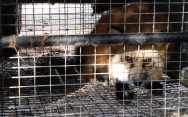Blog Archives
Home -
Posts tagged "Animal Freedom"
As Morocco prepares to host the 2030 FIFA World Cup, there have been reports of mass culling of
stray dogs in an effort to “clean the streets” before the tournament. A collective of ten animal rights
organizations, including Eurogroup For Animals and Four Paws, has written to FIFA, urging the
organization to take a stand against this horrific slaughter. Morocco had previously committed to a
humane dog population management strategy through a ‘Trap, Neuter, Vaccinate, Release’ (TNVR)
program, yet reports suggest that authorities are instead resorting to killing stray dogs in violation of
their own policies and with wanton cruelty.
The Moroccan government has justified these actions under the pretext of controlling rabies, a fatal
disease transmitted through bites. This contradicts the scientific evidence and the government’s
prior commitment to sustainable measures such as TVNR, which are proven to be more effective as
well as being humane. The open letter from animal rights groups calls on FIFA to use its influence to
hold Morocco accountable for its commitments and ensure that dog population management is
ethical, upholds previous commitments and does not sacrifice animal lives.
The situation raises urgent ethical questions about humanity’s treatment of animals that do not
serve our self-interested purposes. Stray dogs, often dismissed as nuisances, are living beings
deserving of dignity and compassion. Their existence in our cities is not their fault but rather a
consequence of human neglect and mismanagement. To kill them for the sake of a sporting event
reflects a disturbing willingness to sacrifice lives for aesthetics and convenience. As a global
institution with immense influence, FIFA has a responsibility to take a stand against cruelty and
support humane solutions.
With five years to go before the tournament, Morocco has the opportunity to stick to ethical and
sustainable measures to care for their stray dog population rather than wantonly killing them. FIFA
must use its platform to pressure the government from preventing a catastrophic mass killing,
ensuring that the World Cup is not tainted by the horrific suffering of animals that are discarded as if
their lives had no meaning. The world is watching, and now is the time to demand a humane
approach that values animal lives as equally.
The Moroccan dog “genocide” must be stopped. Sign the petition to tell FIFA that they must us their
pressure to stop these catastrophic mass killings: https://actionnetwork.org/petitions/the-
international-animal-coalition-is-calling-on-fifa-to-demand-morocco-stop-killing-dogs-for-the-world-
cup
For more on our educational and advocacy programs on behalf of animals, please visit our website:
https://www.freedom4animals.com/
|
Tags: Animal Freedom,
Animal Genocide,
Animal Massacre,
animal rights,
FIFA,
Kevin Boileau,
Morocco,
Nazarita Goldhammer,
Rabies,
Stray Dogs,
TNVR,
Transhumanism,
World Cup
Despite some positive progress in legislation, puppy mills are still a big source of cruelty and neglect,
a fact that is all too real for thousands of dogs across the United States. The ASPCA’s recent poll
revealed that the most important issue for supporters in 2025 is fighting for stronger legislation to
protect puppy mill victims. Large-scale commercial breeding operations continue to operate under
outdated and inadequate regulations. People are beginning to wake up to the fact that this cruelty is
still legally sanctioned, but we are a long way from liberating dogs from puppy mills.
Puppy mills are notorious for their appalling conditions, with many dogs confined to tiny, wire cages
barely large enough for them to turn around. These facilities, which are regulated by the U.S.
Department of Agriculture (USDA), often fail to meet even the most basic welfare standards. Female
dogs are bred relentlessly, producing litter after litter without adequate time for rest and recovery.
Even with laws on the books, these standards are rarely enforced, and commercial breeders that
neglect their animals continue to operate unchecked.
Even the lucky ones who are adopted and rescued from lives of forced breeding have stories of
trauma, their bodies ageing faster than is normal for a well-cared-for dog. Read about the story of
Gracie, a dog who was rescued after 6 years of breeding 100 puppies:
https://www.humaneworld.org/en/blog/mama-dogs-story-why-we-do-work-we-do-stop-puppy-
mills
There have been recent wins, including the passing of the New York Puppy Mill Pipeline Act in
December 2024. This New York legislation bans the sale of cruelly bred pets in retail stores. The
ASPCA report outlines a commitment to building on this momentum by pushing for similar
legislation in other states in 2025. The ASPCA also advocate for Goldie’s Act, a bill that would require
the USDA to enforce stronger oversight of federally licensed facilities, ensuring more frequent
inspections, intervention for animals in need, and better coordination with local law enforcement.
The road to eliminating puppy mills is long, but with continued advocacy, we can reduce the
suffering of countless animals. The fight is far from over, and it’s imperative that we keep working
together to ensure that no dog ever has to endure the horrors of a puppy mill again.
Please read more on the ASPCA Website: https://www.aspca.org/news/poll-results-revealed-which- animal-welfare-initiative-was-voted-most-important-aspca-supporters
For more information about our work at Freedom 4 Animals to educate the public and push for
animal freedom, please click to read: https://www.freedom4animals.com/the-empathy- program/
|
Tags: Animal Abuse,
Animal Advocacy,
Animal Cruelty,
Animal Freedom,
animal rights,
ASPCA,
Commercial Breeding,
Forced Animal Breeding,
Gracie's Story,
Kevin Boileau,
Nazarita Goldhammer,
New York Puppy Mill Pipeline Act,
Puppy Mills,
USDA
A campaign is underway to get Congress to pass the SAFE Act, which has been stalled in congress since last year. Click on the link to sign the petition to stop horses being exported abroad for slaughter:
The US has banned the slaughter of horses at home. However, this ban means nothing while it’s still legal to transport horses thousands of miles to be slaughtered in the horsemeat trade, their last moments spent in the “kill box,” frightened and panicked before being chopped to bits. Wild horse slaughter in the U.S. was shut down in 2007 but the export industry still sends 20,000 horses every year to their deaths in Canada and Mexico. Not only this but the horses first endure long, gruelling journeys in cramped and cruel conditions before they are killed. According to a 2023 report from the American Journal of Veterinary Research, the horse export industry thrives and generates around $500 million a year,
With all the panic surrounding unverified claims that cats and dogs are being eaten in the United States, it’s a good time to draw attention to the plight of horses. The SAFE Act, or Save America’s Forgotten Equines Act (HR 3475/S 2037) is a bill that animal activists have been pushing to get passed for decades. In its current form the SAFE Act amends the 2018 Dog and Cat Meat Trade Prohibition Act to add equines to the list of animals prohibited to be exported slaughter.
Polls show that 83% of Americans oppose horse slaughter. Yet thousands of horses each year face a horrible ending to their lives. The meat industry lobbies to protect the export of horse slaughter by claiming that if horses are not slaughtered, there will be more neglect and nowhere to rehome horses. Contrary to these claims, the export of horses has actually decreased over the years and shelters are ready to rehome horses, the majority of whom can live out happy and productive lives.
Horses are incredibly sensitive animals who need freedom of movement and family bonds with their fellow horses. Capturing them and transporting them for 24 hours to be killed is not only murder, it is prolonged torture.
As well as a petition there is also a website that makes it easy for you to write to your member of congress to pressure them to sponsor and pass the SAFE Act.
At Freedom 4 Animals, we have done extensive work to preserve the right of free-roaming horses to remain with their families and negotiate and advocate to protect horses from mistreatment, neglect and cruelty, as well as education and working with policy-makers and NGOs on legislation and initiatives to support and protect the freedom of horses.
Please read more about the work we do on behalf of horses and other animals.
Performing animals at the circus are held captive, forced to train and perform unnatural routines in front of crowds and to travel long distances in cramped conditions. Their lives are difficult, disorienting, uncomfortable and exposed. Wild animals often escape from the circus and there have been many cases of abuse and maltreatment.
Fortunately the days of performing animals at the circus are numbered. SoulUniverse circus has become the latest circus to drop performing animals from their routine, under pressure from animal rights activists, led by PETA. They join the list of circus companies who have moved beyond using animals like Lions, Bears, Tigers and Elephants. These include Ringling brothers and Barnum and Bailey circus,
Animal control officers had observed animals being mistreated or neglected at the UniverSoul circus. Big cats were locked in cramped cages all day, elephants and tigers were denied veterinary care and animals were often wounded and frequently attempted to escape.
“Exotic” animals are often forced to work to provide entertainment for humans. The circus is one of the contexts in which animals like big Cats, Elephants or Zebras are forced to work, but other examples include rides or at petting zoos. Larger animals are often made into a spectacle and kept in unnaturally cramped and restrictive conditions that are both physically and psychologically distressing. The concept of the circus should be one that revolves around fun, artistry and highly skilled human performers that choose to perform, not animals who don’t consent to be there.
If you’re visiting the circus with children, PETA has a list of animal-free circuses you can consult. (Please check to ensure all information is up to date). https://www.peta.org/wp-content/uploads/2021/06/animal-free-circuses-pdf.pdf
|
Tags: "Exotic" Animals,
Animal Freedom,
Animal Labor,
animal rights,
Bears,
Big Cats,
Circus Animals,
Elephants,
Kevin Boileau,
Lions,
Nazarita Goldhammer,
Tigers,
Working Animals,
Zebras
The slaughter of wild horses is one of the most significant attacks on animals in the US. It hides in plain sight under cover of the BLM’s policy to round up and re-home horses. Animal advocates have obtained documents that show that instead of being adopted, thousands of horses are sold to slaughterhouses.
The slaughter of wild horses is also part of a bigger story about how the US fails to protect horses and willingly allows healthy horses with many happy years of life left to be sold into slaughter.
These problems are connected to the substantial export of horses internationally from the US. The export of horses makes the fate of horses sold into slaughter even more cruel. On top of being violently slaughtered, horses transported internationally have to endure grueling journeys.
Since the practice of slaughtering horses is no longer supported in the US (even if it is technically still legal), horses are exported to Mexico and Canada to be slaughtered. Even if it’s no longer legal to kill horses for meat in the US, the animals can still be sold in the US and exported elsewhere.
So how did wild horses, which should be protected by the 1971 Horses and Burros Act, come to be sold in “kill pens” and transported miles to be slaughtered? The answer is that the Bureau of Land Management’s adoption incentive program isn’t working.
The BLM introduced their adoption incentive program in 2019. The program pays people $1000 to adopt a horse. After the release of a report from The American Wild Horse Campaign in 2021 and a New York Times investigation that showed that hundreds of wild horses were being re-sold to slaughter, the BLM tweaked their adoption policy to include stricter background checks and checks on a horse’s well being. Yet in 2022, a report from The American Wild Horse Campaign found that the problem persisted. A large number of horses were still being sold into slaughter, and the number of horses being sent to slaughter was likely much higher than estimated. Reports by the AWHC found that a coordinated group of people were adopting wild horses and making up to $80,000 by selling the horses into slaughter.
The BLM’s policies of rounding up horses are also generally criticized. Reducing herds to protect ecosystems and saving horses from dying of starvation in drought ridden conditions may be reasonable motivations, but the BLM is also influenced by the interests of livestock farmers competing for resources with the horses. There are many ways around this problem that don’t involve separating horses from the herd and rounding them up. Groups who represent horses are also asking the BLM to re-assess their methods for corralling wild horses for adoption.
The method of rounding up by helicopter would be eliminated by a bill introduced in Congress, The Wild Horse and Burro Protection Act of 2022. The bill would also employ more cowboys to round up the horses and explore humane alternatives to protect horses. For example, some groups have had success with fertility methods to control population. In this way the horses are not separated from their family groups, and they are not snatched in traumatizing round-ups and corralled in conditions that may be unsafe, exposing them to disease, only to be sold into slaughter.
The slaughter of wild horses is part of a broader problem that affects all horses. The problem is that the market for horse slaughter still exists in the US. The ugliness of horse slaughter itself has been exported, while selling horses into slaughter is openly acceptable.
To learn how to get involved in stopping the slaughter of wild horses and all horses in America, visit the websites of horse advocacy organizations such as the AWHC to find out how to support horses. Contact your local animal rights advocacy groups and local representatives to support the passage of the SAFE Act which will permanently ban horse slaughter in the US and the Wild Horse and Burro Protection Act which will require the BLM to update their policies to protect wild horses.
|
Tags: American West,
American Wild Horses,
Animal Freedom,
animal rights,
Bureau of Land Management,
Horse Advocate,
Kevin Boileau,
Mustangs,
National Park,
Nazarita Goldhammer,
Slaughter of Horses,
Wild Horses








Social Media